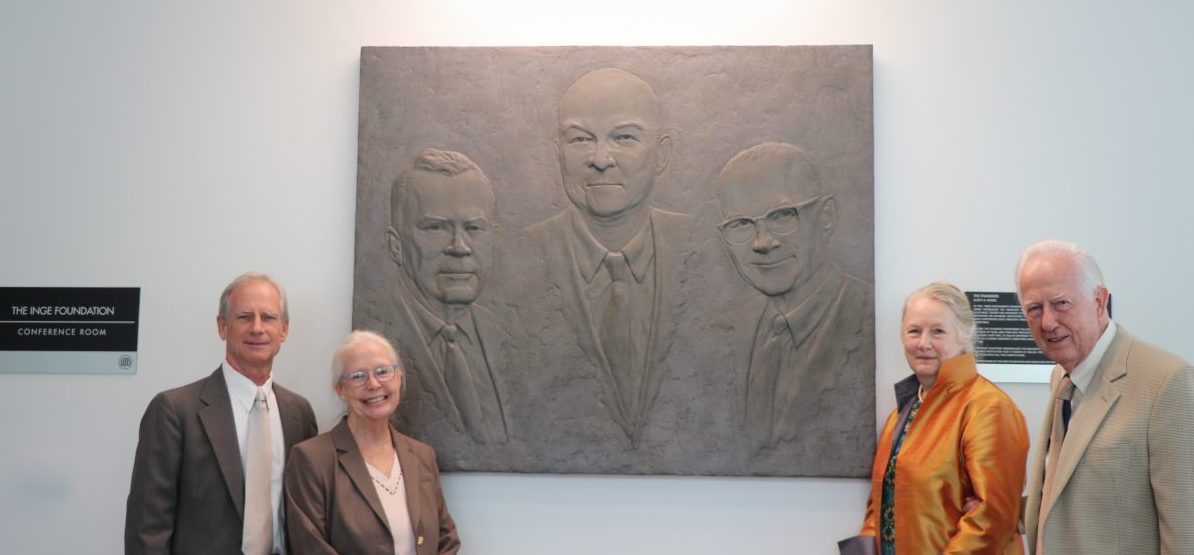Artwork Pays Tribute to University Founders
The Founders, a bronze relief sculpture paying tribute to the vision and ingenuity of The University of Texas at Dallas founders Eugene McDermott, Erik Jonsson and Cecil Green, was unveiled Oct. 29 at a private ceremony attended by alumni, supporters and University leadership during the fifth annual Founders Day festivities on campus. Commissioned by The Inge Foundation, the sculpture was created by artist Scott Myers and features twice life-size images of McDermott, Jonsson and Green.

Commissioned by The Inge Foundation, The Founders sculpture was unveiled on Oct. 29. Representing the foundation are (from left) Peyton Inge, Jana Inge, Dominique Inge and Charles Inge.
“Erik Jonsson, Eugene McDermott and Cecil Green were larger than life in their aspirations and achievements,” said Charles Inge, co-founder of The Inge Foundation. “I do not want any of us to forget the remarkable contributions they made.”
In the early 1960s, Inge, as a young real estate broker, handled the selection and assemblage of an approximately 1,200-acre tract of land north of Campbell Road, then dotted only with farmhouses and sprawling fields. That property became the site of the Graduate Research Center of the Southwest and today is home to the University’s campus. For half a century, Inge has witnessed UT Dallas’ evolution, a transformation sparked by the foresight of the founders. “Those three gentlemen are people I have admired throughout my adult life,” Inge said.
In 2017, Inge and his wife, Dominique, made a gift to the University to name The Inge Foundation Conference Room on the first level of the Davidson-Gundy Alumni Center. The new sculpture adorns the wall just outside the conference room.

Standing next to his original sketch of the University’s founders, artist Scott Myers has work on display throughout the United States and in Italy. He has also sculpted 19 life-size bronze busts displayed in the Pro Football Hall of Fame in Canton, Ohio.
To bring the bronze piece to life, Myers reviewed visuals and historical documentation from around the time when the three men established the Graduate Research Center of the Southwest, a private research institution that in 1969 became UT Dallas. He worked mainly from photographs of the founders, focusing on images of all three men together where he could study them in relation to one another.
“When you are sculpting someone, you want to catch their essence. You want to look at their eyes and not just sculpt their physical likeness, you want to sculpt their character,” Myers said. “I found there was a humbleness about their look and a lot of drive in their eyes.”
Researching the men’s accomplishments and listening to personal anecdotes from Inge helped Myers understand the importance of capturing the subjects’ determination, persistence, focus and intensity.
According to Myers, a relief sculpture is essentially drawing in three dimensions. He began the yearlong process by sketching the figures, adjusting the scale and meticulously reworking the details. With the sketch affixed to a wooden board and coated with lacquer, Myers then used layers of oil-based clay to introduce dimension and depth to the piece. He sought insight from individuals who knew the subjects to ensure the resulting likenesses were truly characteristic.
“This is American history,” Myers said. “These three men pioneered a new way of thinking that changed not only Texas, but also the world.”